
Our technical team has put together this guide to our professional water quality meters, process controller, and electrodes to help you find the right instrumentation for your application.
- Multiparameter pH/ORP/EC/DO/Turbidity Meter | HI9829
- Ion Selective Electrodes
- Turbidity Meters
- Automatic Potentiometric (pH/mV/ISE) Titration System HI902C
- Portable Photometers
- Laboratory Grade Bench Meters
- Benchtop Colorimeter & COD Meter
- Waterproof Portable Meters
- Digital Process Controllers
- Application Specific Electrodes
Find Us at WEFTEC 2016
We are exhibiting at WEFTEC 2016 in New Orleans, LA. If you are a water professional, stop by Booth #1657 and talk to our WEFTEC team to see our water quality meters in action.
- September 26th through September 28th
- Remember Booth #1657
WEFTEC is the annual conference held by the Water Environmental Federation (WEF) and specializes in science and educational solutions for water quality and water management.
Hanna Instruments Commitment to Quality
As a major supplier of water quality meters to companies and organizations across the globe, Hanna Instruments' Research & Development team is constantly working on new and better solutions to solve top water quality challenges. With a completely in-house manufacturing system, Hanna has the competitive advantage of controlling the entire manufacturing and production of our meters, probes, and reagents/solutions.
Hanna's Professional Line of Water Quality Meters
1. Multiparameter pH/ORP/EC/DO/Turbidity Meter | HI9829
Environmental Quality
Industry: Municipal Wastewater, Industrial Wastewater
Parameter: Temperature, pH, ORP, EC/TDS/ Salinity, DO, Turbidity
Product: HI9829

From municipal wastewater treatment plants to a wide variety of industries, treated wastewater is discharged directly into natural waters, including rivers, lakes, estuaries, and bays. In some instances, ecological monitoring is mandatory downstream of the wastewater discharge site in order to ensure there are no significant environmental impacts in these receiving waters.
Typical parameters of interest include temperature, pH, ORP, conductivity, salinity, turbidity, and dissolved oxygen.
The meter offers:
- Waterproof protection of both the meter (IP67) and the probe (IP68) ensures that the internal elements of the meter are protected, despite the harsh weather conditions
- Optional autonomous logging capability of the probe allows the customer to deploy the probe and log measurements for up to 70 days at 10-minute measurement intervals
- Optional integrated GPS receiver allows GPS coordinates to be stored with logged data.
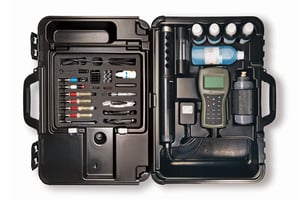
2. Ion Selective Electrodes
a. Fluoridation
Industry: Municipal Drinking Water
Parameter: Fluoride
Products: HI4010, HI5315, HI5222
Although fluoride occurs naturally in some water sources, it is often added to water supply systems to provide health benefits to the public. While the positive effects of fluoride on dental health have been scientifically proven, fluoride can be harmful to health when present above 2-4 ppm.
For the measurement of fluoride in drinking water, Hanna Instruments recommends the HI5222 Benchtop Research Grade pH/ORP/ISE Meter with the HI4010 Fluoride Half-Cell Ion Selective Electrode and the HI5315 Reference Electrode.
The “known addition” incremental method is feature built into the HI5222 for measurement of fluoride at low concentrations. In this method, the user performs a sample reading both before and after adding a standard of known concentration to the sample.
The HI5222 provides built-in prompts and formulas for multiple incremental methods to guide the user through the procedure without having to perform manual calculations. This method provides increased accuracy and repeatability over traditional direct measurement in the typical target range of 0.5-1.5 ppm fluoride.
b. Nitrogen removal
Industry: Municipal Wastewater
Parameter: Ammonia, Nitrate
Products: HI4101, HI4113, HI5222

Ammonia and nitrate are two of the most common measurements performed at municipal wastewater treatment plants to determine nitrogen removal efficiency. Nitrification is the first step of the nitrogen removal process, which occurs in the aeration tank. Bacteria convert ammonium (NH4+) to nitrite (NO2-). Nitrite is then rapidly converted to nitrate (NO3-) by another type of bacteria. The second part of the process is denitrification, where facultative bacteria convert NO3- to N2.
For the measurement of ammonia and nitrate in wastewater, Hanna Instruments recommends the HI4101 Ammonia Ion Selective Electrode, HI4113 Nitrate Ion Selective Electrode, and HI5222 Laboratory Research Grade Dual Channel Benchtop pH/mV/ISE Meter.
Ion selective electrodes offer higher accuracy than photometric measurements in wastewater. Photometric methods are prone to interferences from colored and turbid sample matrices, which are common in wastewater. Additionally, ion selective electrodes are subject to fewer interferences than photometric methods. The dual channel, split screen capability of the allows the operator to measure two samples simultaneously for maximum efficiency.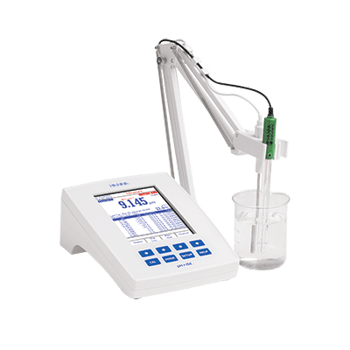
3. Turbidity Meters
Industry: Municipal Drinking Water
Parameter: Turbidity
Product: HI93414

Turbidity is one of the most important measurements required throughout the drinking water treatment process. Suspended particles in water reduce effectiveness of disinfecting chemicals and can act as carriers for bacteria and parasites.
For measurement of turbidity in drinking water, Hanna Instruments recommends the HI93414 Turbidity and Chlorine Portable Meter.
The United States Environmental Protection Agency (USEPA) requires that 95% of post filtration samples in a one month period have a turbidity reading of less than 0.5 NTU, and that no samples exceed 5 NTU at any given time post filtration. The HI93414 meets the USEPA Standard Method 2130B for drinking water, specially designed for low turbidity measurements from 0.00 to 1,000 NTU.
The HI93414 provides the option of an EPA mode in which the readings are rounded according to EPA standards. The HI93414 is supplied with AMCO-AEPA-1 primary standards for calibration. These standards are unique in that they are crosslinked copolymer microspheres suspended in ultrapure water, and are non-toxic and much more stable than formazine standards.
In addition to turbidity, the HI93414 can also be used to measure free and total chlorine for a comprehensive solution for drinking water measurement.
4. Automatic Potentiometric (pH/mV/ISE) Titration System HI902C
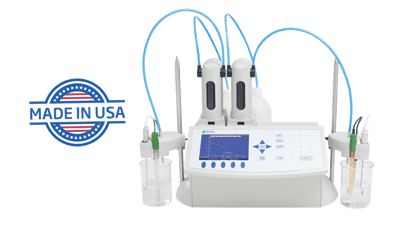
a. Organic Removal
Industry: Industrial Wastewater
Parameter: Chemical Oxygen Demand
Testing the wastewater at any manufacturing site is paramount in ensuring the water released into the waste stream meets the required standards. Large influxes of organic matter into a wastewater treatment plan can overwhelm the plan and result in ineffective waste treatment. Many manufacturers must reduce the organic load of their waste stream before discharging to the sewer, per their pretreatment permit. A common way to determine organic load is the measurement of chemical oxygen demand (COD).
COD is often measured colorimetrically, but this measurement is not ideal for some waste streams that are strongly colored or highly turbid.
For these customers, Hanna Instruments recommends measuring COD via titration with the HI902C Automatic Titration System and HI839800 COD Test Tube Heater.
 The sample is prepared for titration the same way as for a colorimetric test: a blank is prepared and samples are prepared by adding 0.2 mL of sample to a reagent vial. Both the blank and samples are then heated in the HI839800 at 150°C for 2 hours. After cooling, the contents of the vials are carefully transferred and rinsed into 100 mL glass beakers for titration. COD is determined by titrating the excess potassium dichromate in the samples with a ferrous ammonium sulfate titrant.
The sample is prepared for titration the same way as for a colorimetric test: a blank is prepared and samples are prepared by adding 0.2 mL of sample to a reagent vial. Both the blank and samples are then heated in the HI839800 at 150°C for 2 hours. After cooling, the contents of the vials are carefully transferred and rinsed into 100 mL glass beakers for titration. COD is determined by titrating the excess potassium dichromate in the samples with a ferrous ammonium sulfate titrant.
The HI902C Potentiometric Titrator offers a user-friendly interface and result logging traceability for reporting purposes, and can be used for additional parameters such as acidity, alkalinity, and more.
b. Sludge Processing
Industry: Municipal Wastewater
Focus: Sludge Processing
Parameter: Volatile Acidity, Alkalinity
The growing demand for alternative energy sources and reducing waste in America has resulted in increased research being done on alternative fuels. One alternative form of energy is biogas.
To convert organic materials such as sludge and food scraps to biogas, the materials are first delivered and placed in an anaerobic digester to be broken down. During primary fermentation volatile short-chain fatty acids (VFA) are produced, and in a secondary fermentation the VFAs are converted to volatile organic acids (VA), primarily acetic acid, which is then converted to biogas. Fermentation occurs at the desired rate when total volatile acid levels are below 1500-2000 mg/L and acetic acid levels are below 1000 mg/L.
Another important parameter to measure is the buffering capacity of the digester, reported as alkalinity. The ratio of the volatile acids to alkalinity are an important indicator of digester health. If volatile acid levels exceed the buffering capacity of the digester, the pH level drops and the microorganisms responsible for converting the acid to biogas are inhibited.
Hanna Instruments recommends the HI902C potentiometric titrator with the HI1131B pH electrodepH electrode for volatile acidity and alkalinity titrations in sludge digesters. These two titrations can be performed sequentially on one sample, automatically starting the volatile acids titration after the conclusion of the alkalinity titration without having to prompt the instrument between measurements.
Also, consider the Hanna HI921 Autosampler for better efficiency.

5. Portable Photometers
a. Iron and Manganese Removal
Industry: Municipal Drinking Water
Parameter: Iron and Manganese
Product: HI96742
Manganese and iron are two of the most abundant metals in the Earth’s crust; however, their presence in water can stain plumbing. The USEPA lists iron and manganese under their National Secondary Drinking Water Regulations due to their undesirable aesthetic effects on water and fixtures.
In areas with high concentrations of manganese and iron, a treatment system such as a greensand filtration system can be used. Greensand filters utilize a fine media that has been treated with a manganese oxide to adsorb and oxidize incoming dissolved manganese and iron. Over time, these greensand filters become saturated and require backwashing.
For the monitoring of manganese and iron removal, Hanna Instruments recommends the HI96742 Portable Photometer for Low Range Manganese and Low Range Iron. The measurement range for manganese is from 0 – 300 μg/L with 1 μg/L resolution, which corresponds to 0 – 0.300 mg/L with 0.001 mg/L resolution, giving them high levels of accuracy in their expected concentration of 0.05 mg/L. The HI96742 provides an accurate, fast, and affordable way to monitor iron and manganese.
b. Disinfection
Industry: Municipal Drinking Water
Parameter: Free and Total Chlorine
Product: HI96711C
Chlorine is the most commonly utilized disinfect in drinking water municipalities. This is due to the persistence of chlorine throughout the distribution system, known as residual chlorine. This residual free chlorine ensures safe drinking water makes it all the way from the treatment plant to our homes.
For a portable solution for the measurement of free and total chlorine throughout the treatment plant and distribution network, Hanna Instruments recommends the HI96711C Free and Total Chlorine Portable Photometer Kit.
The HI96711C kit includes a rugged carrying case, sample cuvettes, microfiber cloth, and CAL Check™ standards for free and total chlorine. The NIST traceable CAL Check standards are used to validate that the meter is working to specifications, providing peace of mind that the measurements obtained are accurate. The HI96711 uses an adaptation of USEPA method 330.5 and Standard Method 4500-Cl G, and measures from 0.00-5.00 mg/L for free and total chlorine. The HI96711 features 0.01mg/L free and total chlorine resolution from 0.00 – 3.50 ppm, and 0.10 mg/L resolution above 3.50 mg/L, and an accuracy statement of ±0.03 mg/L ±3% of the reading.
6. Laboratory Grade Bench Meters
Hanna's 5222 laboratory grade meter is recommended for use with the Fluoride, Ammonia, and Nitrate ISEs for fluoride monitoring and nitrate removal, and as discussed above.
The 5000 series has other specialized uses:
Organic Removal
Industry: Municipal Wastewater
Parameter: Biological Oxygen Demand
Product: HI5421 
One of the main objectives of wastewater treatment is to remove organic matter prior to being released into a body of water. Biochemical oxygen demand, commonly referred to as BOD, is an empirical measurement of the oxygen required by bacteria to decompose organic matter. Therefore, the efficiency of a wastewater treatment plant can be determined by measuring the BOD concentration.
For this application, Hanna Instruments recommends the HI5421 Research Grade Dissolved Oxygen and BOD Meter.
The HI5421 comes equipped with the necessary BOD calculations programmed into the meter. This allows the user to simply take and log an initial DO reading, and after the 5 day incubation period, log a final dissolved oxygen reading. The meter then automatically calculates and displays the BOD5 in mg/L. The HI5421 makes management of BOD data simple; intuitive sample setup prompts the user for input of the seed volume, sample volume, and predilution factor. A sample ID can be set for each sample, and logged data can be easily transferred to a PC via USB port and included software.
The HI5421 meter comes standard with the HI76483 Polarographic Dissolved Oxygen Probe, featuring a built-in temperature element which proves helpful to ensure measurements were taken at the required temperature of 20°C.7. Benchtop Colorimeter & COD Meter
Organic Removal, Nutrient Removal
Industry: Municipal Wastewater
Parameter: Chemical Oxygen Demand, Nitrogen, Phosphorus

Biochemical oxygen demand (BOD) and chemical oxygen demand (COD) are parameters used to determine the amount of organic matter in water. BOD measures the amount of oxygen consumed by microbes to breakdown organic matter. COD measures the amount of organic pollutants by the amount of oxygen consumed during the chemical oxidation of organic matter and inorganic chemicals such as ammonia and nitrite. BOD is a more accurate quantification of the readily available organic matter than COD; however, BOD requires a five-day incubation to obtain a measurement, making it difficult to make real-time adjustments. Measuring COD allows for wastewater facilities to make real-time operational adjustments when necessary, and to evaluate the effectiveness of their treatment.
For this application, Hanna Instruments offers the HI83314 Wastewater Photometer and HI839800 COD Test Tube Heater. Hanna offers three varieties of COD reagent types: mercury-free, USEPA 410.4 compliant, and ISO compliant versions. The HI83214 measures other common parameters in wastewater such as ammonia, total nitrogen, reactive phosphorus, and total phosphorus. The HI839800 has two predefined temperature settings, 150ºC for COD and phosphorus digestion, as well as 105ºC for total nitrogen digestion, enabling them to use the same reactor for all sample preparation.
8. Waterproof Portable Meters
a. Aeration Tank
Industry: Municipal Wastewater
Parameter: pH, DO
Product: HI98196

The majority of nitrogen removal occurs in the aeration tank, where nitrogen-rich wastewater undergoes a series of oxidative-reductive processes. Since nitrification is a microbial driven process, monitoring the environment in the aeration tank is critical for maintaining sufficient microbe population. Although a variety of analyses are performed, the two most important parameters in the aeration tank are pH and dissolved oxygen.
For a portable solution for measurement of pH and DO in aeration tanks, Hanna Instruments recommends the HI98196 Portable pH and DO Meter.
The HI98196 is a waterproof portable multiparameter meter with a multisensor probe. The probe features two sensor inputs: a potentiometric input for either a pH or pH/ORP sensor, and a dissolved oxygen input for a galvanic DO sensor. With the HI98196, operators can simultaneously measure and view pH, ORP, DO, and temperature with one instrument. The HI98196 probe has a weighted shield to protect the sensors and ensure the probe sinks within the tank, allowing the operators to easily take measurements at various depths. The galvanic DO probe has a quick start up time, unlike their previous polarographic DO probe which required 10-15 minutes to polarize before calibration and measurement could be performed. The cable lengths for the probe start at 13ft and go up to 130ft. The HI98196 meter, probe, and all accessories are supplied in a rugged thermoformed carrying case.
The HI98196 provides a durable, accurate, and convenient solution for taking measurements in aeration tanks.
b. Stormwater Monitoring
Industry: Municipal Wastewater, Industrial Wastewater
Parameter: pH
Product: HI98190
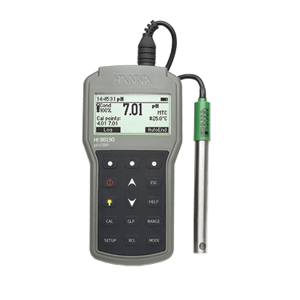
Stormwater is a term for the runoff water resulting from a precipitation event in urban areas. As stormwater flows over impervious surfaces, chemicals, pollutants, debris, and sediment are gathered. This pollutant and nutrient-rich stormwater ultimately drains into sewers, where it continues to a wastewater plant for treatment or into a natural water body such as rivers, lakes, wetlands, and estuaries. Many local authorities dictate that stormwater leaving an industrial site must be within a pH range of 6.5 to 8.5.
For these applications, Hanna Instruments recommends the HI98190 Waterproof Portable pH/ORP Meter.
The HI98190 is waterproof and comes supplied with the HI12963 titanium bodied pH electrode. The durability of both the meter and electrode, along with the rugged carrying case, provide peace of mind that the equipment will have a long lifespan, even when used in stormy conditions. The CAL Check™ feature of the HI98190 allows the operator to view and report when the meter was last calibrated to ensure compliance in their pH reporting. The log-on-demand feature allows the customer to log the pH reading, date, and time of each measurement for ease of reporting later.
9. Digital Process Controllers
In line monitoring
Industry: Municipal Wastewater, Industrial Wastewater
Parameter: pH
Product: HI504
In many industrial and wastewater treatment processes, pH is a critical parameter.
For the inline monitoring and adjustment of pH, Hanna Instruments recommends the HI504 pH/ORP Digital Controller with Sensor Check™.
The HI504 offers:
- A measurement range from -2.00 pH to 16.00 pH, accuracy of +/- 0.02 pH
- The ability to configure with one or two pH/mV set points to activate dosing pumps or alarms if the pH/mV of the solution is too high or too low.
- Single or dual analog outputs that can be connected to a recorder for the cataloging of process data or can be used for controller dosing systems using on/off, proportional, or PID control.
- Advanced safety features including temperature level alarm and sensor check capabilities.
To take advantage of these features the HI1000 series pH electrode with a pt100 temperature sensor and matching pin must be used. The temperature level alarm will deactivate the dosing relays in the event that the neutralization process becomes exothermic and potentially melt a holding tank. The sensor check feature uses the matching pin to constantly check the impedance of the glass sensor and the reference junction, identifying a potentially broken or dirty electrode. All settings can be password protected to prevent unwanted changes. All events including errors, changes to settings, and power interruptions are logged for review as well.
10. Application Specific Electrodes
pH monitoring
Industry: Municipal Drinking Water
Parameter: pH
Product: FC215D [sold with Hanna HI99192 pH Meter]

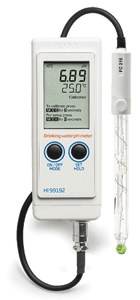 The pH of drinking water is a vital measurement; it affects everything from taste and odor, to corrosion or scaling throughout the distribution system, to disinfection effectiveness. Drinking water can be either sourced from surface water (lakes, rivers, and streams) or groundwater. Surface water is typically lower in mineral content, and therefore, conductivity, than groundwater. In low conductivity samples, pH readings will be slow to stabilize and tend to drift.
The pH of drinking water is a vital measurement; it affects everything from taste and odor, to corrosion or scaling throughout the distribution system, to disinfection effectiveness. Drinking water can be either sourced from surface water (lakes, rivers, and streams) or groundwater. Surface water is typically lower in mineral content, and therefore, conductivity, than groundwater. In low conductivity samples, pH readings will be slow to stabilize and tend to drift.
For optimal pH measurement of low conductivity water, Hanna Instruments recommends the FC215D amplified pH electrode with glass body. The FC215D has three ceramic junctions in the outer reference cell providing for 40 – 50 μL/hour of electrolyte to flow from the electrode into the sample. This increased flow provides a greater continuity between the reference electrode and the indicating electrode, making it suitable for water of low conductivity.
To ensure optimal flow of electrolyte, be sure to unscrew the electrode fill cap so that it is loose or open whenever you are calibrating or taking measurements. This allows for positive head pressure to be created allowing for the electrolyte to drain more easily from the reference electrode.
